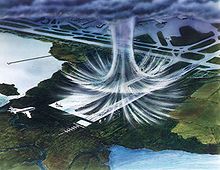Wind shear

The wind shear is a wind whose wind strength or wind direction changes in a small geographic area. Strong wind shear can affect or even endanger the flight of aircraft.
If an aircraft penetrates this area, its movement will only adapt to the suddenly changed wind direction and strength with a delay. This means that, depending on the wind direction , an additional lift or loss of lift due to increasing or decreasing flow against the profile acts on the wings . Horizontal shear winds can arise at the gaps in chains of hills and large rows of buildings as well as the result of a microburst (downwind or vertical wind shear) that is deflected on the ground in a horizontal direction (outflow).
The driving force is large air pressure differences, in which the wind movement acts as a compensation. Close to the ground, this weather phenomenon represents a potential danger, especially when aircraft are landing. In December 1992, a McDonnell Douglas DC-10 crashed on Martinair Flight 495 due to wind shear in Faro . Another example is Lufthansa flight 2904 . The Airbus A320 was hit by wind shear while landing in Warsaw in September 1993 and then rolled over the end of the rain-soaked runway. In August 1985, Delta Air Lines Flight 191 was hit by wind shearers. The Lockheed L-1011 TriStar was knocked to the ground and moved down a highway, killing a driver before exploding near the Dallas airport . 134 people died, only 29 survived. This flight sparked intensive research into the early detection of wind shear. Some of them can now be recognized by ground-based Doppler radar or LIDAR . On board, they can usually only be recognized by the Ground Proximity Warning System (mode 7) when flying in .
See also
literature
- Niels Klussmann, Arnim Malik: Lexicon of aviation . 3. Edition. Springer-Verlag, Berlin, Heidelberg 2012.